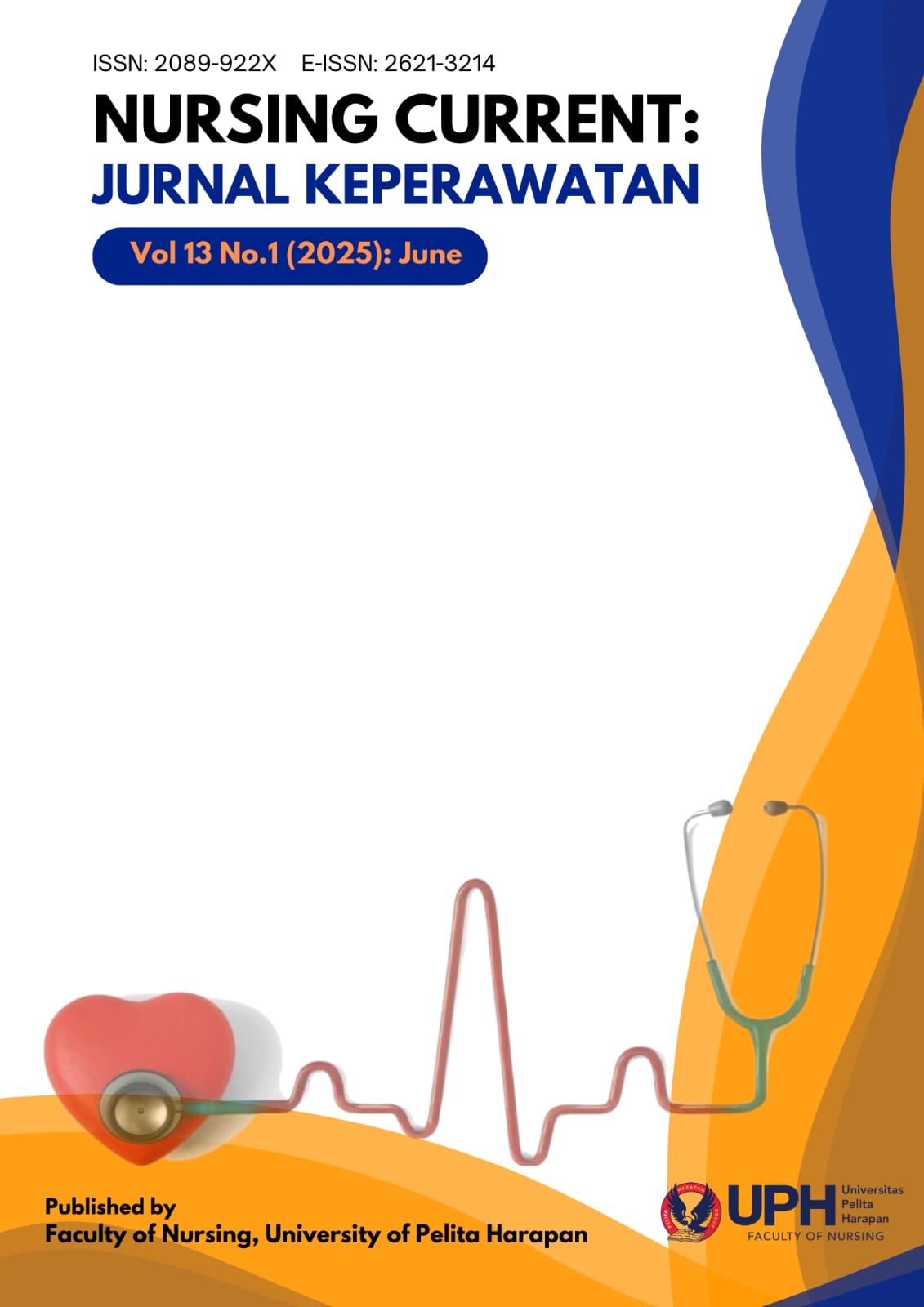Factors Influencing Mosquito Nest Eradication in Dengue Hemorrhagic Fever Prevention
DOI:
https://doi.org/10.19166/nc.v13i1.9863Kata Kunci:
Dengue Hemorrhagic Fever, Health education, Knowledge, Mosquito Nests EradicationAbstrak
Dengue hemorrhagic fever (DHF) poses a significant public health in Indonesia. Despite government efforts to control disease vectors, the rising population density and mobility in Tangerang Regency have contributed to the rapid spread of DHF. This highlights the urgent need to eradicate mosquito nests for outbreak management and prevention. This study aims to identify risk factors associated with mosquito nest eradication in the Tangerang Regency. A cross-sectional design was used, with 400 participants selected through convenience sampling. Data were analyzed using logistic regression. The results of the multivariate analysis revealed age (p-value = 0.012), knowledge (p-value = 0.001), and support from healthcare workers (p-value = 0.003) as variables linked to mosquito nests eradication. Knowledge was the most dominant variable (OR = 5.857); individuals with low knowledge levels were 5.8 times less likely to engage in mosquito nest eradication compared to those with high knowledge after being controlled for age and support from health workers. These findings underscore the urgency of addressing these risk factors. Nurses can play a key role by providing health education to the community, emphasizing the importance of regularly draining and cleaning water containers, covering water storage, and reusing or recycling waste to reduce mosquito breeding sites.
Referensi
Akello, A. R., Byagamy, J. P., Etajak, S., Okadhi, C. S., & Yeka, A. (2022). Factors influencing consistent use of bed nets for the control of malaria among children under 5 years in Soroti District, North Eastern Uganda. Malaria Journal, 21(1), 363. https://doi.org/10.1186/s12936-022-04396-z
de Oliveira, F. L. B., Millions, R. M., da Costa, M. V., de Almeida Júnior, J. J., & e Silva, D. G. K. C. (2016). Estudo comparativo da atuação do enfermeiro no controle de dengue e febre chikungunya. Saúde e Sociedade, 25(4), 1031–1038. https://doi.org/10.1590/s0104-12902016160638
Heryanto, E., & Meliyanti, F. (2021). Hubungan pengetahuan, pekerjaan, dan penyuluhan dengan tindakan kepala keluarga dalam upaya pencegahan penyakit demam berdarah dengue (DBD). Lentera Perawat, 2(1), 8–16.
Hossain, M. I., Alam, N. E., Akter, S., Suriea, U., Aktar, S., Shifat, S. K., Islam, M. M., Aziz, I., Islam, M. M., Islam, M. S., & Mohiuddin, A. K. M. (2021). Knowledge, awareness, and preventive practices of dengue outbreak in Bangladesh: A countrywide study. PLOS ONE, 16(6), e0252852. https://doi.org/10.1371/journal.pone.0252852
Istiqomah, I., BM, S., & Husodo, B. T. (2017). Faktor-faktor yang berhubungan dengan upaya pencegahan demam berdarah dengue (DBD) pada ibu rumah tangga di Kelurahan Kramas Kota Semarang. Jurnal Kesehatan Masyarakat (e-Journal), 5(1). https://doi.org/10.14710/jkm.v5i1.15831
Jeelani, S., Sabesan, S., & Subramanian, S. (2015). Community knowledge, awareness, and preventive practices regarding dengue fever in Puducherry, South India. Public Health, 129(6), 790–796. https://doi.org/10.1016/j.puhe.2015.02.026
Ministry of Health Republic of Indonesia. (2016). Profil Kesehatan Indonesia 2016. http://www.depkes.go.id/resources/download/pusdatin/profil-kesehatan-indonesia/Profil-Kesehatan-Indonesia-2016.pdf
Ministry of Health Republic of Indonesia. (2018). InfoDatin situasi demam berdarah dengue. https://www.kemkes.go.id/download.php?file=download/pusdatin/infodatin/InfoDatin-Situasi-Demam-Berdarah-Dengue.pdf
Marha, D. A., Fatah, M. Z., & Winarko, W. (2020). The role of health workers and community leaders to prevent dengue hemorrhagic fever in Magetan, East Java. Jurnal PROMKES, 8(2), 172–181. https://doi.org/10.20473/jpk.V8.I2.2020.172-181
Ndjinga, J. K., & Minakawa, N. (2010). The importance of education to increase the use of bed nets in villages outside of Kinshasa, Democratic Republic of the Congo. Malaria Journal, 9(1), 279. https://doi.org/10.1186/1475-2875-9-279
Nguyen-Tien, T., Do, D. C., Le, X. L., Dinh, T. H., Lindeborg, M., Nguyen-Viet, H., Lundkvist, Å., Grace, D., & Lindahl, J. (2021). Risk factors of dengue fever in an urban area in Vietnam: A case-control study. BMC Public Health, 21(1), 664. https://doi.org/10.1186/s12889-021-10687-y
Rakhmani, A. N., Limpanont, Y., Kaewkungwal, J., & Okanurak, K. (2018). Factors associated with dengue prevention behaviour in Lowokwaru, Malang, Indonesia: A cross-sectional study. BMC Public Health, 18(1), 619. https://doi.org/10.1186/s12889-018-5553-z
Rau, M. J., Soraya, N., & Pitriani. (2019). Faktor-faktor yang berhubungan dengan upaya pencegahan demam berdarah dengue (DBD) di Kelurahan Birobuli Selatan. Preventif: Jurnal Kesehatan Masyarakat, 20(2), 73–82. https://jurnal.fkm.untad.ac.id/index.php/preventif/article/download/122/88/
Sanyaolu, A. (2017). Global epidemiology of dengue hemorrhagic fever: An update. Journal of Human Virology & Retrovirology, 5(6). https://doi.org/10.15406/jhvrv.2017.05.00179
Torondek, J., Kaunang, W. P. J., & Wariki, W. (2019). Hubungan antara pengetahuan dan tindakan pencegahan dengan kejadian demam berdarah dengue (DBD) di Lingkungan III Kelurahan Airmadidi Atas Kabupaten Minahasa Utara. Jurnal Kesehatan Masyarakat Universitas Sam Ratulangi Manado, 8(7). https://ejournal.unsrat.ac.id/index.php/kesmas/article/view/27143
Veras-Estévez, B. A., & Chapman, H. J. (2017). Health workers’ perceived challenges for dengue prevention and control in the Dominican Republic. MEDICC Review. https://doi.org/10.37757/mr2017.v19.n4.7
Wharton-Smith, A., Rassi, C., Batisso, E., Ortu, G., King, R., Endriyas, M., Counihan, H., Hamade, P., & Getachew, D. (2019). Gender-related factors affecting health seeking for neglected tropical diseases: Findings from a qualitative study in Ethiopia. PLOS Neglected Tropical Diseases, 13(12), e0007840. https://doi.org/10.1371/journal.pntd.0007840
World Health Organization. (2024). Dengue and severe dengue. Retrieved from https://www.who.int/news-room/fact-sheets/detail/dengue-and-severe-dengue
Wild, C. F., Nietsche, E. A., Salbego, C., Teixeira, E., & Favero, N. B. (2019). Validation of educational booklet: An educational technology in dengue prevention. Revista Brasileira de Enfermagem, 72(5), 1318–1325. https://doi.org/10.1590/0034-7167-2018-0771
Wong, L. P., Shakir, S. M. M., Atefi, N., & AbuBakar, S. (2015). Factors affecting dengue prevention practices: Nationwide survey of the Malaysian public. PLOS ONE, 10(4), e0122890. https://doi.org/10.1371/journal.pone.0122890
Unduhan
Diterbitkan
Cara Mengutip
Terbitan
Bagian
Lisensi
Hak Cipta (c) 2025 Deborah Siregar, Lenny Harefa, Milka Rambu Andu Uma

Artikel ini berlisensiCreative Commons Attribution-ShareAlike 4.0 International License.
Authors who publish with this journal agree to the following terms:
1) Authors retain copyright and grant the journal right of first publication with the work simultaneously licensed under a Creative Commons Attribution License (CC-BY-SA 4.0) that allows others to share the work with an acknowledgement of the work's authorship and initial publication in this journal.
2) Authors are able to enter into separate, additional contractual arrangements for the non-exclusive distribution of the journal's published version of the work (e.g., post it to an institutional repository or publish it in a book), with an acknowledgement of its initial publication in this journal.
3) Authors are permitted and encouraged to post their work online (e.g., in institutional repositories or on their website). The final published PDF should be used and bibliographic details that credit the publication in this journal should be included.

This work is licensed under a Creative Commons Attribution-ShareAlike 4.0 International License.






